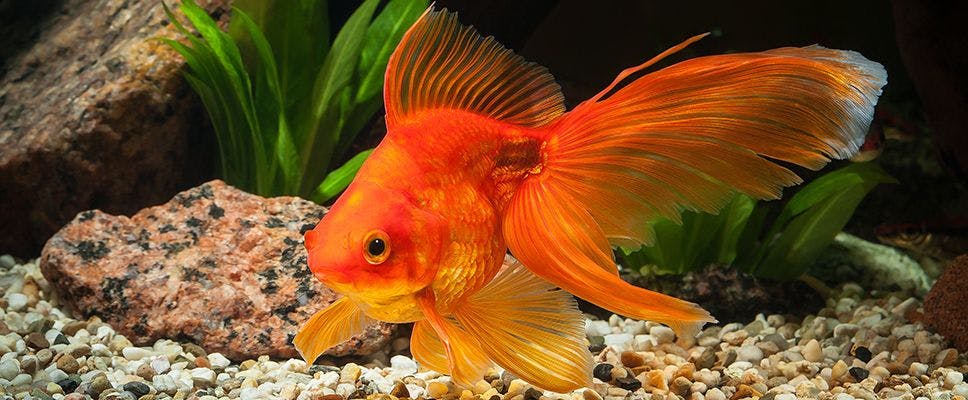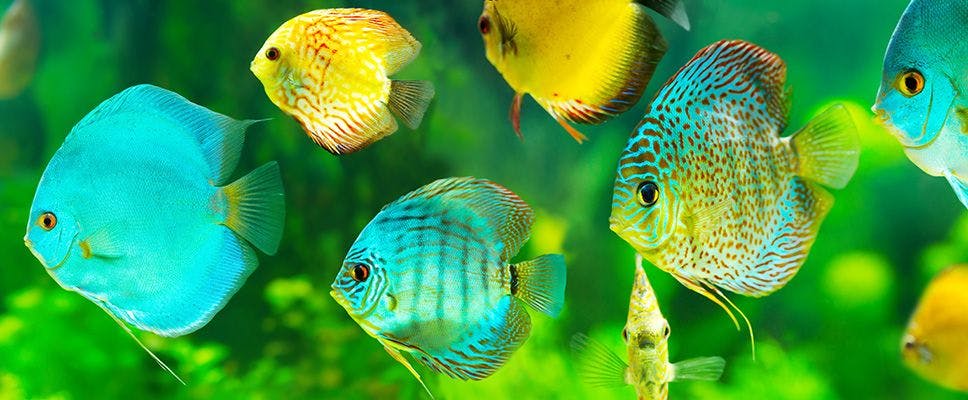
Fish make fantastic pets as they are relatively low cost and come in a variety of different breeds.
Setting up an aquarium is not complicated, but there are important steps that must be followed to ensure your set up is successful.
Tropical Vs Cold Water
There are two types of domestic fish; tropical and cold water. While each has unique requirements and characteristics, there is a common set of rules that can be applied when choosing and setting up a tank, conditioning the water, adding new fish and maintaining the delicate ecosystem of the aquarium.
Before purchasing your aquarium and products, you will need to decide if you want to keep cold water or tropical fish.
Tropical fish
Popular because of their brilliant colours and shapes, they give an exotic feel to your aquarium. However, they are slightly more challenging to care for than cold water fish and have specific needs, like a heater.
Cold water fish
Great for beginners, cold water fish have similar care requirements however they are more robust than tropical fish and your tank won’t require a heater.

Feeding Your Fish
One of the biggest causes of fish fatalities is from over feeding. If you feed your fish too much, they will produce more waste than your filter can handle, resulting in nitrate build up and creating a poor tank environment. Aim for two feeding sessions daily, feeding only the amount your fish can eat within 30 seconds.
PETstock has a fantastic selection of top quality fish food to choose from.
For new aquariums, feed fish every second or third day for four weeks, to keep nitrate levels down.
Have one or two days a week where you do not feed your fish. This will allow your fish to scavange for any uneaten food helping to keep your tank cleaner.
Choosing Your Aquarium
After choosing which type of fish you will keep, you will need to decide on an appropriate aquarium. Factors you will need to take into consideration before purchasing your aquarium are:
Species of fish
- Size your fish will grow to
- Amount of space you have available
- Amount of fish you would like to have
- Your budget
If purchasing your first aquarium, it is a good idea to start with a 40 – 100 litre setup. The larger the water volume in the tank, the more stable the water conditions will be.
The most important piece of equipment needed for your tank will be a filter. There are quite a few different filter designs and sizes to choose from, so ask your PETstock team for advice on the right filter for your specific tank.
If you have decided to purchase tropical fish, your tank will also need a heater.
Again, heaters are available in many sizes so enquire as to what will be the best option for your tank.
Filters and air pumps are very important in tropical tanks, as the higher water temperature results in less oxygen available in the water.
Setting Up Your Aquarium
1 – Placing Your Aquarium
Put some thought into where your tank goes. It should be in an area where the light and temperature of the tank will not be affected by external sources, such as windows and heater vents. Your tank should also be placed away from direct sunlight (the main cause of algae growth).
You will need to place your aquarium on a stand that will be able to hold the total weight. You will also want to be sure that the floor is able to support the weight of the aquarium and stand. Make sure you position the tank before filling it up, as it will weigh a lot more when full.
2 – Cleaning Your Gravel, Tank and Other Ornaments
Be sure to wash your gravel and ornaments thoroughly before adding to your tank, as they may contain residual dust. Clean the inside of your tank with paper towel and water before filling. Do not use chemicals or detergents to clean your tank as this will leave residue which may be harmful to your fish.
Rinse your gravel in a solution of water and DE chlorinator prior to putting it in your tank, as tap water does contain chlorine.
3 – Filling Your Tank
When adding water, place a small plate in the bottom of your tank and pour slowly into tank over the plate, to minimise cloudiness in the water. Don’t be concerned if the water is slightly cloudy, as it should settle within a couple of hours. If settling is taking longer, ask your PETstock team about water clarifying products.
4 – Adding Ornaments, Plants & Equipment
Add ornaments, plants and equipment to your tank when it is approximately half full. Be sure not to turn your filter, air pump and heater on just yet. Ensure the heater is adjusted to the right temperature for your specific fish. For tropical tanks, heat the water to between 23 - 26 degrees Celsius. Cold water tanks should be around 12 - 20 degrees Celsius. Finish filling your tank before you turn on the filter, heater and air pump.
5 – Cycling Your Tank
Before adding your fish, you need to make sure there is substantial biological bacteria present in the water. The bacteria will help break down the waste your fish will produce. Doing this is extremely important as if there is a build-up of waste, harmful nitrates may be produced which are dangerous to your fish’s health.
For optimal results, run your tank without fish for approximately two weeks to allow the biological process to start. Ensure your heater and filter are turned on during this time.
Adding live plants to your tank is a great way to kick-start the biological process.
6 – Testing Water Parameters
PETstock offer free in store water testing. Performing a water test is an important step in ensuring all parameters are at a safe level for your fish. The four main things you will be testing for are PH, ammonia, Nitrate and GH. Desired reading of these tests depend on the species of fish you have, but a general recommendation is:
- PH: 7
- Ammonia: under 1PPM
- Nitrate: under 10PPM
- GH: 50 to 150 PPM
7 – Adding fish
Adding your fish to their new tank will be the most exciting part of this process. It is recommended that you add two fish at a time (preferably heartier, less expensive fish) and allow at least three days before adding more.
When placing fish in the tank, float them in the bag they were sold to you in for no longer than 20 minutes. Add small amounts of water in to the bag during this time, to allow your new fish to adjust to the new tank water.
8 – Regular maintenance
Using a water chemistry test kit, check pH, ammonia and nitrate levels weekly. Increased ammonia and nitrite may indicate over-feeding or problems with the biological filter. Tanks become acidic over time, resulting in a drop in pH, so this needs to be maintained. Regular checks allow you to catch problems early and save your fish from suffering.
Fortnightly: Perform a partial water change fortnightly. As the aquarium is a closed environment, over time nitrates, organic acids and wastes accumulate in the water. The only way to prevent this becoming a problem is to perform a partial water change.
Only ever change 25% - 30% of the water at one time, as any more will affect the biological filter.
Algae Control
Ensure algae does not invade your tank by keeping it out of direct sunlight and only keeping the aquarium light on 8 - 10 hours a day.
Any algae can be cleaned off the glass with various scrapers and wipes available at PETstock.
AQUARIUM CHECK LIST
✓ Aquarium
✓ Aquarium gravel
✓ Aquarium Filter
✓ Aquarium light (essential for tropical)
✓ Airpump (optional but recommended)
✓ Other decorations (such as fake or real plants)
✓ Aquarium test kits to test water parameters for PH and others
✓ Fish food
✓ Heater (for tropical fish only)
✓ Gravel Cleaner
✓ Fish net
✓ Magnet Cleaner/ Scrubbing brush or sponge
✓ De Chlorinator. See staff for range
✓ Biological Bacteria Product. See staff for range
✓ Aquarium salt
✓ PH Neutral regulator/ PH Up or Down (Depending on species)
✓ Thermometer (optional)
Other products may be required depending on the type of fish you wish to keep. A PETstock team member will be able to provide further recommendations about what products you will need.